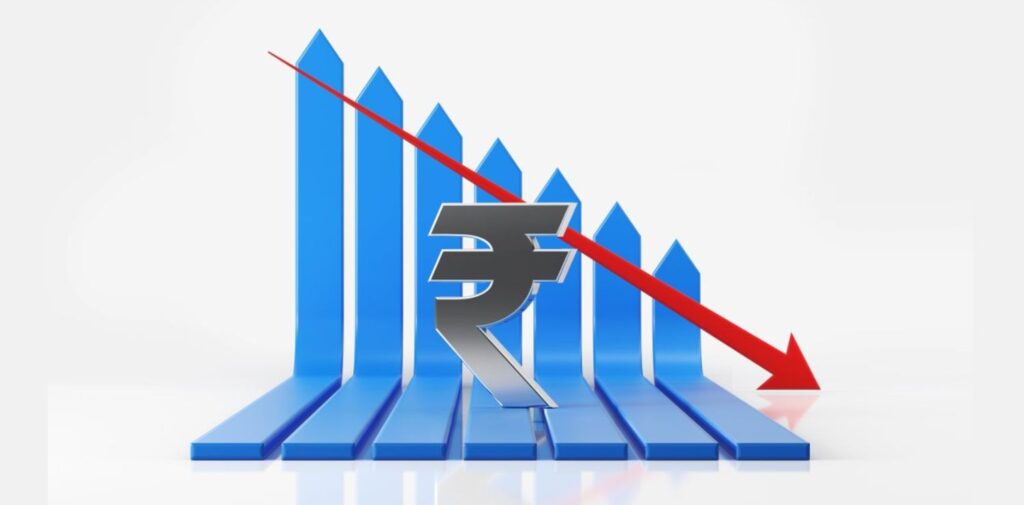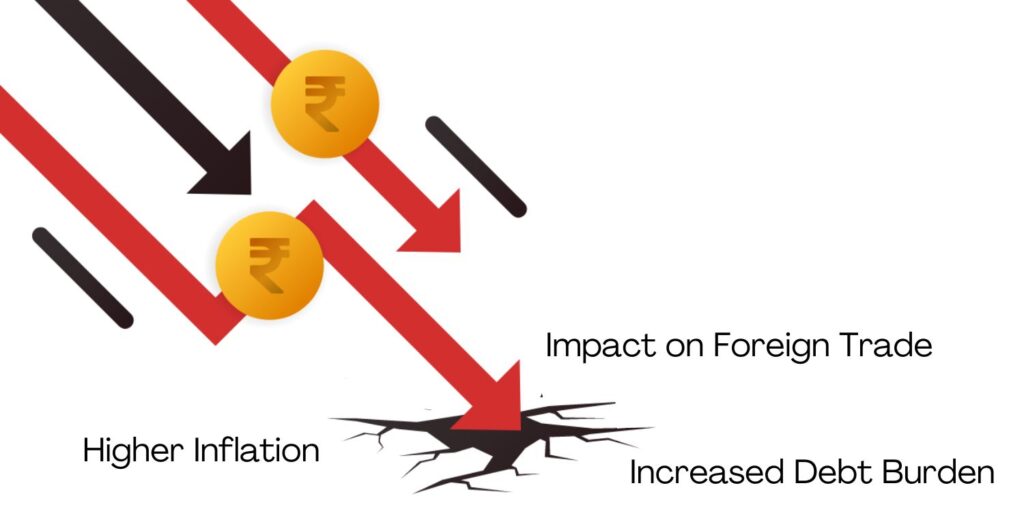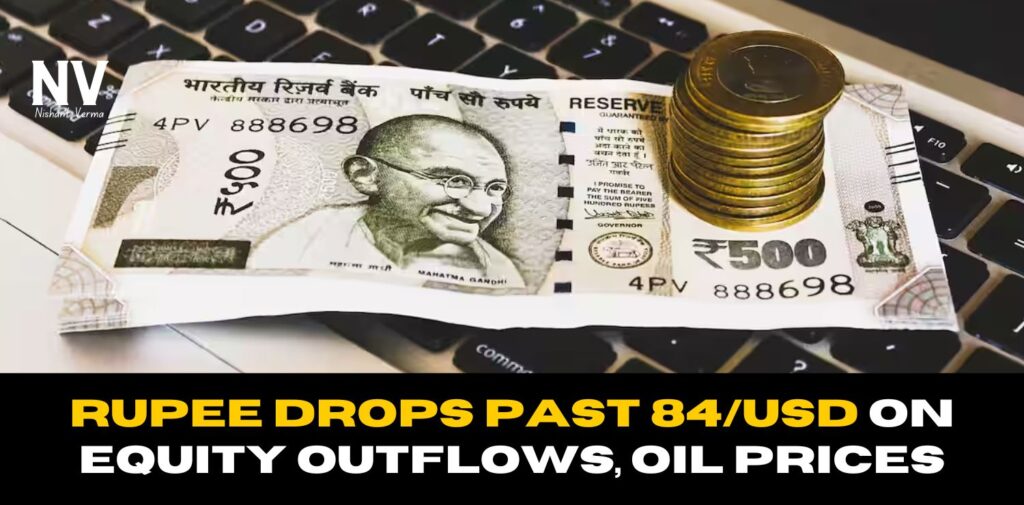The Indian rupee recently hit an all-time low of 83.99 against the US dollar, mainly due to rising global oil prices and outflows from Indian equities. This significant depreciation highlights economic vulnerabilities exacerbated by external and domestic factors. In this article, we will explore the underlying causes of the rupee’s decline, assess the broader implications for the Indian economy, and examine how this may affect various sectors, especially real estate.
Key Drivers of Rupee Drops
- Rising Oil Prices: One of the primary reasons for the rupee drops is the surge in global crude oil prices, driven by supply constraints and geopolitical tensions. Since India is a net importer of oil, higher oil prices increase the country’s import bill, leading to a higher demand for dollars. This, in turn, weakens the rupee. The increased expenditure on oil imports has strained India’s current account deficit (CAD), making it harder to maintain foreign exchange reserves and balance payments.
- Foreign Equity Outflows: Foreign Institutional Investors (FIIs) have been pulling out of Indian equities, contributing to the depreciation of the rupee. With rising interest rates in developed markets like the US, FIIs are finding safer and higher-yielding investment opportunities elsewhere. As they convert rupee holdings into dollars, the demand for the greenback increases, causing the rupee to slide further.
- Geopolitical Tensions and Global Economic Uncertainty: Ongoing global issues, such as the Russia-Ukraine conflict, have created significant volatility in international markets. These geopolitical tensions have not only pushed up oil prices but have also impacted global trade routes and supply chains. As a result, emerging economies like India have experienced capital flight towards more stable and developed economies, increasing pressure on the rupee.

Economic Impacts of a Weakening Rupee
- Higher Inflation: A weaker rupee makes imports more expensive, driving up the costs of essential goods like crude oil, chemicals, and electronic components. This leads to inflationary pressures, with businesses passing on higher costs to consumers. Inflation has been a persistent challenge for India, and a depreciating rupee could make it more difficult for policymakers to control rising prices, especially in sensitive areas like fuel and food.
- Impact on Foreign Trade: While a weaker currency can make Indian exports more competitive, the benefits may be limited due to the increased cost of imported raw materials. Moreover, global demand is slowing down amid recession fears, reducing the potential for export growth. For a country that relies on both imports and exports, the devaluation of the rupee presents a mixed bag.
- Increased Debt Burden: India has external debt obligations in foreign currencies, particularly the US dollar. A falling rupee increases the cost of servicing these debts. The government and corporations with dollar-denominated loans will need to spend more rupees to meet their obligations, which can put a strain on fiscal budgets and corporate balance sheets.

Sectoral Analysis
Real Estate:
The real estate sector could face mixed consequences from the rupee’s depreciation. On one hand, Non-Resident Indian (NRI) investments might increase as they find property prices more attractive due to a favorable exchange rate. NRIs often invest in high-end properties in India, and the weakening rupee can catalyze more inflows.
On the other hand, rising inflation and costlier imports (especially construction materials like steel and cement) may increase construction costs, putting pressure on real estate developers. Moreover, high inflation can reduce domestic demand for real estate as household incomes get squeezed by higher prices for everyday goods and services. Developers might struggle to pass on higher costs to homebuyers, especially in a price-sensitive market like India’s.
Manufacturing and Automotive:
The manufacturing sector, especially industries reliant on imported inputs like automotive and electronics, will face challenges as the cost of raw materials increases. The automotive industry, in particular, relies heavily on imported parts, and the falling rupee could raise production costs, potentially leading to price hikes. At a time when the industry is already recovering from supply chain disruptions and semiconductor shortages, this could further delay the sector’s recovery.

Tourism and Aviation:
For outbound tourism, a weaker rupee means higher costs for Indians traveling abroad. Airfares, hotel accommodations, and other expenses become more expensive, which may reduce the number of Indian tourists traveling overseas. Conversely, inbound tourism to India could benefit, as foreign visitors find India cheaper in dollar terms, potentially boosting the hospitality and tourism sectors.
IT and Outsourcing:
India’s IT and outsourcing sectors could see benefits from the rupee depreciation. Companies in these sectors earn a significant portion of their revenues in foreign currencies, primarily US dollars. A weaker rupee translates into higher revenue when converted back to rupees, which could offset some of the inflationary pressures and help maintain profitability. However, this benefit could be temporary if global demand for IT services weakens amid broader economic uncertainties.
Policy Response and Government Actions
The Reserve Bank of India (RBI) has intervened in the foreign exchange markets by selling US dollars to stem the rupee’s fall. However, this has led to a depletion of India’s foreign exchange reserves. The central bank faces the challenge of balancing inflation control with exchange rate management. Raising interest rates could help curb inflation and support the rupee, but it could also stifle economic growth and dampen domestic demand.
The government is also exploring ways to reduce the impact of high oil prices, such as negotiating long-term supply contracts with major oil-exporting nations and promoting alternative energy sources to reduce the dependency on crude oil imports.
Conclusion
The recent depreciation of the rupee to 83.99 against the US dollar underscores the challenges that India faces in a volatile global economic environment. While certain sectors like IT and real estate may find pockets of opportunity, the broader economy is likely to grapple with inflationary pressures, rising debt costs, and reduced investor confidence. Addressing these issues will require a coordinated policy response from both the government and the RBI, with a focus on maintaining economic stability, boosting exports, and managing external vulnerabilities.
As India navigates these challenges, it will be essential to strengthen domestic industries, diversify energy sources, and attract foreign investment sustainably. The rupee’s depreciation is not an isolated event but a reflection of larger economic shifts, and how India responds in the coming months will be crucial for its long-term economic resilience.




